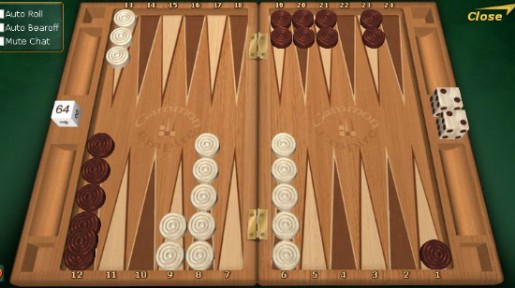Isn’t Backgammon a bit too cerebral for players of slots and table games?
Not at all - leaving aside the fact that most forms of Poker require plenty of intelligence to excel in - there are casino versions of Backgammon available in many bricks and mortar establishments today, which means that some of the reputable online casinos should follow on soon enough.
Just to reiterate, we’re not saying gamers are stupid - quite the reverse, which is why we’re confident you’ll easily be able to digest this brief intro to this ancient game, now being presented with a modern twist, and hopefully it will whet your appetite to try it out and learn more…
Brief run-down of the rules
Backgammon has 24 alternating red (or black) and white cone/triangle shapes, split into 4 groups of 6. Red starts at one end of the board (which is split into 2 halves), white at the other, and the winner is the one who gets his or her 15 counters, or chequers to the home board and ‘bears them off‘ the board.
The cones are numbered relative to the player so what is triangle number 1 for the white player is number 24 for the red and vice versa (NB the chequers move in decreasing numbers starting at 24 down to 1).
There is also another die or ‘doubling cube‘, which shouldn’t be forgotten when you learn to play Backgammon.
The board is set up with 2 of your chequers on triangle 24 (ie. The beginning of your opponent’s board) 5 on cone number 13, 3 chequers on number 8, and 5 chequers on number 6.
After rolling to decide who goes first, a player rolls to decide how many triangles his/her chequers move forwards. The rules for Backgammon state that this can be done in 2 ways, either moving 1 chequer by the total number, or 2 by the 2 separate numbers on the dice. The chequers can only be placed on an open triangle, which is one with no more than 2 opposing chequers on it.
In the case of moving just the one chequer, there must be an open triangle the number of spaces after its starting point that ONE of the 2 dice shows. For example, if the dice come up as 5 and 3, making 8, the chequer can be moved to an open triangle 8 ahead, but also there MUST be an open triangle at EITHER 3 OR 5 triangles ahead from the starting point.
The exception to this is double numbers, which are great because you get to use BOTH numbers TWICE (eg. if you get a double 6 you get to move 4 separate chequers forward by 6 triangles each, if you can).
What happens in the rules of Backgammon if triangles are not open? A player must use all the numbers he or she can (including all 4 of the doubles numbers): if only 1 can be played, then that 1 is played, or the higher number if either/or are possible. If you can’t move at all you lose your turn
If you land on a triangle with an opposing player’s chequer on it (called a ‘blot‘), you kick them off and put their chequer on the ‘bar‘. A player with a chequer on the bar must put it on the opposing players home board before doing anything else, on the higher of the 2 numbers which come up on the dice (losing a turn if neither is possible). If you have more than one chequer, you keep doing this, until either all are entered (when the ‘unused’ number on the dice is used to move either the last entered chequer or another) or any which cannot be entered are left behind and you lose your turn.
Bearing off is an important aspect of how to play Backgammon, and happens when you have all 15 chequers on your own home board. Roll the dice and bear off any chequers on the corresponding number(s)Â from the highest numbered roll first. So if you roll a 4 and a 2, making 6, you remove from the 4 and the 2 cones. If for example there is nothing on the 4, but you have 2 chequers on the 2, you ‘use’ both dice numbers to remove the 2 chequers on the 2 cone.
There are two ways of winning under Backgammon rules, a ‘gammon‘ (if you bear off all your chequers before your opponent has borne off ANY of his) or a ‘backgammon‘ (the same but the opponent has chequer(s) on the bar).
The doubling die is used to determine stakes when playing for money. You start at 1. If a player is feeling confident, he or she can double the stakes by simply turning the die to its ‘2’ face and so on up to 64 as you want; refusing to accept a double that your opponent proposes means forfeiting the game.
That’s it! We hope it was interesting, and watch out for more articles on Backgammon in the future.

